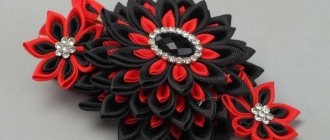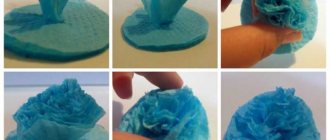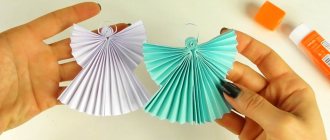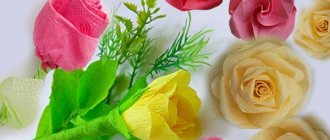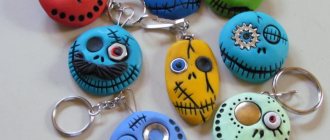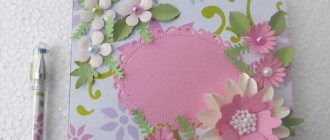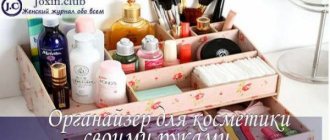About foamiran
In Russia, the material is known as foamiran, but synonyms are also common: fom (foam), revelour, plastic suede, porous rubber. The name came from the Iranian company Foamiran, the world leader in the production of sponge materials (from the English foam - foam).
Inventive Iranians have established the production of material from petroleum products. If you look at it, foamiran means foam rubber, produced in the form of thin layers.
Foamiran Source fabalabse.com
The Iranian company, having launched the production of foamiran, began with twelve pastel shades. The needlewomen got acquainted with the new product and highly appreciated its capabilities.
Foamiran is a polymer product made on the basis of ethylene vinyl acetate (ester), produced in the form of soft sheets with a porous structure.
Structure of plastic suede Source roomester.ru
Decorative foamiran can be purchased both in the form of individual sheets and sets with a different number of colors. Sets of 8-10 sheets of similar shades (for example, yellow), or sets of 30-40 sheets of a wide color palette are common. The size of the material in the sets is A4 (23x30 cm) or A5 (23x15 cm), the average thickness varies between 1-2 mm.
Assorted set Source charivna-mit.com.ua
Soft porous rubber feels velvety to the touch, reminiscent of thin suede or loose velvet paper. Since organic substances are used in production, foam has virtually no odor. After unpacking it may smell a little “chemical”, but the smell, however, quickly disappears.
In different shades Source zabota024.msp.midural.ru
Application
Plastic suede is used in various areas of needlework. Floral compositions made from foamiran for the interior are widespread. Flowers made using a special technology are difficult to distinguish from natural analogues; they look just like fresh roses or daisies. Floral works made from foamiran do an excellent job as interior decor; you can make flowers that will fit exactly into your living room.
Bouquet for the living room Source lachat.ru
Based on realistic miniature (and not so miniature) buds and leaves, craftswomen make an unlimited variety of jewelry: hairpins, brooches, rings, headbands and other jewelry.
Wreath on the head Source i.pinimg.com
The properties of the material allow it to be used in scrapbooking (design of photo albums and diaries), for decorating postcards and gift packaging. Compositions of flowers made from foamiran will decorate the wedding ceremony.
Christmas tree decorations made from foam Source i.ytimg.com
Plastic suede will help develop the child's creative abilities; It makes original crafts and applications. Experienced craftsmen create figurines of realistic animals and birds, and funny toys. Three-dimensional paintings with imitation of natural materials (wood, leather) look exclusive.
Positive butterfly Source www.dombusin.com
Properties
The composition, texture and variety of colors predetermined the properties of the product, which turned out to be useful in home creativity. The material is loved by creative people due to the following unique qualities:
- Easy to use. To make beautiful flowers from foamiran, you don’t need complex equipment or special skills. Even a beginner, with some perseverance, can work with it.
Available to everyone Source beadstree.ru
- Plastic. The most useful quality. When heated, foamiran becomes pliable, easily stretches and deforms, and after cooling it retains its new shape. For molding, the heat of an iron, a candle, or just your hands is enough. The desired look is given to the workpiece manually or using simple techniques (for example, by pulling the workpiece onto a rounded shape).
Hairpins Source www.passionforum.ru
- Environmentally friendly. Plastic suede does not emit substances into the air that are hazardous to the health of people and animals. Children can also work with it - it meets all the requirements of safety standards, which is confirmed by an external ISO certificate.
large flowers from foamiran Source sima-land.com
- Artificial material is easily cut and pierced with a figured hole punch, leaving no sharp edges; It is impossible to get hurt on it, which is ideal for children's creativity.
Lily Source roomester.ru
- The material is quite durable and easy to maintain. Rubber (which, in fact, is what foam is) is not afraid of water, so dirt from products and crafts can be wiped and washed off with clean water or with the addition of soap.
Astra Source amazon.com
Important! Plastic suede, being rubber in composition, melts and burns like any rubber. This must be remembered when heating parts over an open candle fire. In children's creativity, this technique is used only under the strict supervision of adults.
See also: Companies specializing in the production of finishing materials
Hydrangea from foamiran - video instructions for making
Lilac or hydrangea - these inflorescences of small flowers look gorgeous in bouquets. The work of making them is long and painstaking.
You will need many small parts measuring 1-1.5 cm, which are assembled into an overall composition
To make small flowers, it is better to stock up on a figured hole punch; it will greatly simplify the task. The process of creating a hydrangea flower in this detailed video:
Using glue and paint
When working with revelour, you cannot do without adhesives and dyes. The following methods are used for gluing parts:
- It is most convenient to use a hot silicone glue gun. This is the best option for those who work with the material regularly.
Working tools Source roomester.ru
- If you don’t have a glue gun, you can replace it with PVA glue in a package with a dispenser. PVA is white in color, but after drying it becomes transparent. Suitable for gluing small decorations to crafts. It’s good if there are two dispensers: for application over a large area and for spot work.
- Foam is also easily glued with any quick-fix polyurethane adhesive a la “Moment” or “Crystal”. This composition is universal: transparent, waterproof and provides high adhesive strength.
In the interior palette Source travel-dom.ru
Foamiran can be painted, since the porous structure ensures good absorption of dyes. The following compositions are best suited for work:
- Experienced craftswomen prefer to apply shades with pastels (crayons or rimless pencils). Many people prefer oil pastels over dry pastels.
Dry pastel Source www.artpinok.ru
- Cosmetics have proven themselves well: multi-colored cosmetic pencils, eye shadow, and sometimes lipstick.
- If you have the skill and time, you can use oil paints for toning and more detailed drawing. The effect is excellent, but you will have to wait several days for the work to dry.
Tinting Source i.pinimg.com
It is possible, although not recommended, to paint foamiran parts with watercolors or acrylic paints. Water-based paints do not interact well with the rubber surface of parts. Watercolor paints weakly and unevenly, as it flows into droplets. Acrylic paint dries with an inelastic film, and after a while it cracks and crumbles.
Large flowers in the interior Source oazis.hu
Peony from foamiran
We will need material at least 1 mm thick to make the craft voluminous and strong. Color range: dark green, dark pink and light pink. You will also need green isolette, water-based paints, strong wire, a glue gun, and any decor for forming the core of the flower.
Step 1.
We form a pattern from plain paper. To do this, simply draw the future petals on paper or print out our photo hint. When the blanks are drawn, start cutting them out, where you should get:
- Petals A – 10 light pink;
- Petals B – 10 light pink and 5 dark pink;
- Petals C – 10 light pink;
- Petals D – 5 dark pink;
- Petals E – 5 dark pink;
- Leaves Z – 3 dark green;
- Leaves M – 6 dark green;
- Leaves K and L – 5 dark green;
- Core F – 1 piece (cut out sharp rays from a circle).
Step 2
You need to color your petals so that the color on the petal is darker towards its edge and base. This way we will get more realistic flowers. If the petal is dark pink, then use dark pink paint. The petals need to be painted on both sides.
And then we move on to painting the leaves. On one side of which you need to draw veins, like a real plant. See our photo tip.
Step 3
To make our petals voluminous, they need to be folded correctly. The corrugation of the petals begins with the letter B, which we fold like an accordion. The upper part of our petal needs to be twisted more tightly, and when you unfold the petal you will see how realistic it has become.
Don't miss: How to sew a duvet cover
Next, we do the same with the petals of group A. But the petals of group D need to be done differently. You need to give them a concave shape, as shown in the photo. We do the same with the petals of group E.
And we make petals C in the same way as a group of petals B. Now we move on to our leaves. They need to be folded in half and stretched. On the sides, you should crumple the foamiran into folds to create the effect of a frill of a leaf.
Step 3
We make a large ball out of foil, which will be the main one for our flower. The diameter of the ball should be approximately 1.5 cm. Using glue, we attach our wire to the ball, and put a core blank on it, as indicated in the photo.
We roll up the sharp rays of the workpiece and use yellow paint to make stamens. Next, using a glue gun, you need to glue ten petals of group A to the core. Then comes the turn of group B - alternating dark pink and light pink.
The next row comes with petals from group C - 5 pieces, and after another 5 from group C. Then we glue group D - 5 pieces, placing them in a checkerboard pattern. The completion of the bud will be the largest petals. Then you need to glue the leaves of groups K and L.
As a result, we got such a beautiful, delicate and voluminous peony.
How to choose the thickness of the foam
It is difficult for a beginner to understand the variety of varieties and sizes of revolver offered by the market. To make spectacular and unusual flowers from foamiran, a brooch or a toy, it is important to choose the right variety that is best suited for a particular craft.
Greeting card Source lachat.ru
First of all, you need to decide on the thickness. It is an important criterion for a successful result. The following thicknesses are suitable for different crafts:
- Fomm thickness 3 mm or more. The thickest sheets make excellent appliqués, puzzles and decorations; they are the easiest for children to work with.
Asters Source roomester.ru
- Fomm 2 mm thick. An ideal choice if you want to make a toy and a life-size flower and keep children busy with creativity. The dense material is durable and elastic, suitable for appliques, toys, and garlands.
- Thickness 1-1.5 mm. They work with thin sheets if you need to make a bouquet of flowers for the living room, a brooch, or elegant decor for a hair hoop. The delicate and plastic material produces fairly thin parts.
Ranunculus Source www.passionforum.ru
- Experienced craftsmen who specialize in creating realistic interior flowers from foamiran prefer the thinnest sheets, 0.6-0.8 mm. This thickness allows the part to be stretched to translucency.
- For complex parts (pistils, stamens, berries), it is better to use marshmallow foam, or purchase them ready-made.
Material of any thickness is produced in Iran and China. Turkish and Korean manufacturers produce thin varieties (from about 6 to 1 mm).
Indistinguishable from the real one Source italstroy.ru
Aerobatics: peony flower
Delicate and luxurious peony is a complex design made of many petals of different shapes and sizes. In the center there are sharp parts with uneven edges, along the edges there are rounded blanks.
This design will take more than one hour, but the result will certainly please you.
We invite you to read the detailed step-by-step instructions from experienced craftswoman Nadezhda Konovalova:
How to choose the type of foam
On sheets of any production, small holes may occasionally appear, but they are not considered a defect. When cutting, several parts of complex shapes are cut out from one sheet; You can always choose a layout in which the hole remains in the edge.
Worse, if the sheet is painted unevenly or its thickness varies from edge to edge, such defects often make high-quality work impossible. Generally similar, the material from different manufacturers differs in some parameters.
Bouquet in an envelope Source wedding.uz
Iranian foamiran
The material is traditionally considered the highest quality on the market. It can be purchased in individual sheets measuring 60x70 cm, A4 (21x31 cm) or in rolls. The advantages of Iranian products are:
- Fine-porous structure, with a high level of elongation and impeccable shape retention.
Bouquet for the bedroom Source lachat.ru
- Wide color palette: more than 30 shades, from rich to pastel.
The Iranian product is pleasantly predictable: under the influence of heat, the parts are somewhat reduced in size, which must be taken into account when cutting.
Flowers from Iranian foamiran Source i.pinimg.com
Video description
About existing types of foamiran in the following video:
Chinese
Its main advantage is the price, half that of the product from an Iranian factory. It has a thicker, rougher structure, resembles matter and stretches less well.
When ordering a product online, you can receive both excellent foam and not the quality you expected. The risks also concern physical properties: when heated, the part will not shrink, but increase in size, or even bubble.
The Chinese product is supplied in rolls of 1x2 m, sheets of 0.5x0.5 m or A4 format.
The advantages of the Chinese product are good tensile strength (better than Iranian) and an inspiring palette of shades.
Orchid Source i0.wp.com
What you will need
To work with foamiran, you need auxiliary tools and materials that will help make the flowers realistic. These include:
- The revelour itself is in the required colors.
- Hot melt adhesive for joining parts. It is advisable that the gun have a narrow nose, otherwise a drop of glue could burn the petal.
large flowers from foamiran Source i.pinimg.com
- Scissors. For large elements, ordinary ones are suitable; for especially small ones, it’s worth stocking up on manicure ones.
- Iron. An indispensable item for homework. The material heats up on it and becomes pliable to work with.
- Materials for coloring and tinting. Pastel, oil paints.
Tulips Source roomester.ru
If you want to understand how to make flowers from foamiran, you need to get acquainted with some specialized tools and materials. In order for the flowers to look realistic, the following were invented for adherents of floral design:
- Tools for creating relief. To make the flower look natural, you will need special molds-casts from living plants that form the surface texture - molds and weiners. These are casts of leaves and petals of real plants made of plastic or silicone. Forms can be universal or for a specific type of flower.
Mold for foamiran Source i.ytimg.com
- Bulki. Needed for the formation of deep petals (for example, for a peony), they come in many sizes.
- Tape. Tape with an adhesive backing, designed for processing stems.
A set of Japanese instruments Source i.pinimg.com
- Floral wire. Differs in caliber, color and length. Stamens are made from the thinnest wire, and stems, leaves, and inflorescences are made from more popular wire.
- Flock powder. Creates the effect of a velvety surface, needed in order to make fluffy leaves and stamens indistinguishable from real ones.
Floral ribbon Source livemaster.ru
The simple magic of wildflowers
Wildflowers, with all their simplicity, can become part of a very sophisticated composition, fresh and delicate. They look good if you choose a variety of flowers of different colors and shapes.
In a field bouquet, daisies, poppies and cornflowers, yellow buttercups look gorgeous
Find out how to make some of your favorite flowers in our instructions.
How to make a chamomile flower - instructions for beginners
Chamomile is just a seemingly simple flower. It is not so easy to make it from Thomas - it will require patience and many miniature parts.
| Illustration | Description of action |
| Using the miniature template, draw and cut out 30 small petals from white foam foam. | |
| Make a fringe from a strip of yellow fom. Carefully cut the material with scissors at a minimum distance. | |
| Give relief to the chamomile petals using tweezers. Just heat up the workpieces and run tweezers over the hot material. | |
| Bend the stem wire at the tip to form a hook. Insert the tip of the fringe into it. | |
| Rotate the stem while gluing the fringe to create the center of the flower. | |
| Heat the finished core over a candle. The fom will become thinner and the core will look very natural. | |
| Hot glue the first row of petals. | |
| Attach the second row so that the lower petals fit between the upper ones. | |
| Cover the reverse side of the flower with a curly detail. You can then attach a hairpin or brooch pin to it. |
Poppy flower from foamiran: pattern and video instructions
Another favorite wildflower is the bright poppy. It looks great both in company with daisies and on its own in hairpins and brooches.
Poppy flower pattern
The peculiarity of this flower is its middle. How to make it correctly from plastic suede is described in the video instructions:
Manufacturing principles
There are many master classes and video tutorials on the Internet on making flowers from foamiran. There you can also select diagrams and templates for patterns of future decor, which need to be printed and cut out of cardboard.
Roses from foamiran Source avatars.mds.yandex.net
For one small rose, you need to prepare several strips of foam 30-40 cm long and 4-5 cm wide (for a sheet size of 60x80 cm). For large flowers made of foamiran (roses or peonies), more material will be needed. Then the work goes through the following stages:
- Preparing the petals. It takes the most time, about 60-70%. Therefore, it is better for a beginner to choose a flower in which most of the details are typical; This will help speed up the preparation of the required quantity.
Cutting out typical parts Source blogspot.com
- Sometimes it is advised to make a bud rose first. You can use blanks for it without cutting them into separate petals.
- The templates are transferred to the material and cut out. The petals are made realistic using pastels and a sponge.
Blanks Source roomester.ru
- The petals are shaped using a moderately heated iron. Each part is individually applied to the surface of the iron, after heating it is carefully stretched and given the desired (convex) shape with your fingers.
- Product assembly. The petals are attached to the middle. It is made from foil by twisting it into a cone and inserting a wire at the bottom. The petals, starting with the smallest ones, are glued to the foil so that it is not visible.
Ready rose Source roomester.ru
- A green foam backing is glued to the bottom of the flower. This detail is also given a realistic look with pastels.
- Floor flowers made from foamiran will require careful work on the stems, leaves and center (if there is one). A large flower needs a strong base; Often a metal-plastic pipe is used for the stem.
Full size flowers Source static.wixstatic.com
You can start working
The first thing we need to make flowers from foamiran with our own hands is diagrams and templates.
Schemes and templates of leaves and flowers from foamiran
Each plant has its own unique shapes of petals and leaves, so you will need a lot of patterns. Here are some examples of petals and leaves. To understand which form to choose, you should take a closer look at the real flower.
YOU WILL NEED IT
You can download flower and leaf templates from foamiran quickly and for free!
Flower templates from foamiran
Foamiran leaf templates
The sequence is standard: cut out templates from cardboard, transfer them to a sheet of foam using a pencil, pen, or press the outline with a toothpick.
Basic assembly techniques and principles
Petals and leaves of fresh flowers have texture and volume, so our blanks should be pulled and twisted a little. There are several basic techniques with which flat, lifeless material will turn into quivering petals:
- Molds and weiners . In order to transfer the relief of these matrices to the workpiece, it must be heated with an iron, placed on a mold, covered with weiner and pressed firmly for a few seconds. That's it, a beautiful leaf with real veins is ready. You can quickly produce many parts this way.
- Bulki . The workpiece should also be first heated, then a hemisphere should be squeezed out with balls of various diameters to create a three-dimensional petal. The method is suitable for forming parts from thick foamiran.
- Corrugated paper can also serve as a “mold”, you just need to take floral paper with a density of 120 g with flute A or B. This option will work for thin revels.
- Manual shaping . Soft and pliable foam rubber can be folded like an accordion, rolled between your fingers, and stretched lengthwise and crosswise. In this way, the desired shape is acquired, but the texture is erased.
Plastic suede is easy to shape by hand
When all the necessary preparations are formed, you can begin to collect the flower. The base is wire frames, foil or foam balls, and beads. The consumption of foamiran depends on the size of the flower, so you must first select the necessary templates, count how many petals and leaves you will need, and mark future blanks on the sheet.
Video-MK on making roses, basic techniques for working with the material
Useful tips for creating flowers from foamiran
To create not just copies of fresh flowers, but masterpieces, you should know some secrets:
- In different batches of plastic suede, the shade of the same color may differ. Therefore, if you need to make many identical colors or a large composition in one shade, then you should calculate the required amount of material in advance.
- To ensure smooth edges when punching with a figured hole punch, you should place a regular sheet of paper on top of the foamiran.
Blanks for mini flowers are ideally obtained using a figured hole punch
- When working with a hot gun, you need to be careful - if a drop of silicone drips onto the foam, it will melt it.
- Formed parts cannot be reheated, as this causes the relief to disappear and the finished products lose their shape. For this reason, plastic suede and products made from it should be stored away from heat sources.
- When heated slightly, foamiran stretches, and when overheated, it contracts.
- Long exposure to direct sunlight causes bright colors to fade.
- The sheets must be stored straightened and the finished products in a loose state, otherwise creases will form that will be almost impossible to straighten.
The material is very delicate, so creases form easily
- Foamiran can be made thinner; to do this, the workpiece needs to be stretched between your fingers, and large sheets should be ironed through the paper with a warm iron and, while the material is still warm, stretch it. This procedure will help get rid of air bubbles in the foam rubber, compact it and reduce its thickness.
- Plastic suede has a moderate water-repellent effect, so products made from it can be washed in soapy water and, if there are no small parts or wires, even machine washable.
- Neither a hot gun nor liquid glue is suitable for fastening particularly small parts - such elements are sewn together like fabric. But due to the nature of the material, the needle must be thin.
- Sometimes the finished flower begins to straighten. This is due to the fact that when painting with paint, a lot of moisture was applied, it was absorbed into the pores of the rubber and made it soft.
To avoid damaging the petals, apply the paint with a sponge.
- If the foamiran is glued to the iron, then the temperature is set to high, the maximum allowed mode is wool or silk.
Take a look at this master class; using the example of making a daisy, it describes techniques for shaping using an iron.
Of course, these are not all subtleties, for example, it is better to cut thin strips not with scissors, but with a sharp stationery knife, you can draw thin veins with a felt-tip pen, and shade the edges and create an ombre effect with a cotton pad. There are so many craftswomen, so many secrets. Once you start working with foamiran, the material itself will tell you how best to process it.
Author - Anna Devushkina
As an example, look at these photos of a master class on creating a headband from dandelions. Here, thin cutting, heating, rolling, and decorating the stem with tape are used.
Briefly about the main thing
In the field of handicrafts, materials and techniques constantly appear that open up new opportunities for the production of unique hand-made gizmos. Foamiran has become a popular material for needlework due to its ability to change shape when heated, and after cooling, maintain the change.
Plastic suede has found wide application. It is used to make interior flower arrangements, wedding decor, jewelry, and dolls; used to decorate cards and photo albums.
Russian needlewomen know material from Iran, China, Korea and Turkey. It varies in quality, thickness and color, and is sold in the form of rolls and sheets.
To work with foamiran, you need to stock up on scissors, glue, an iron and materials for painting and tinting. Foam floristry masters use additional devices, molds and weiners.
Schemes and patterns of patterns are available in large quantities on the Internet. Beginning fans of this art should choose a simple, small-sized model to master the technique.
Ratings 0

